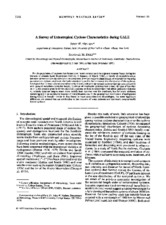| dc.creator | Nielsen, John | |
| dc.creator | Dole, Randall | |
| dc.date.accessioned | 2016-10-28T18:05:56Z | |
| dc.date.available | 2016-10-28T18:05:56Z | |
| dc.date.issued | 1992-07-01 | |
| dc.identifier.citation | Nielsen, J. W., and R. M. Dole, 1992: A survey of extratropical cyclone characteristics during GALE. Mon. Wea. Rev., 120, 1156-1167. | en |
| dc.identifier.uri | https://hdl.handle.net/1969.1/158213 | |
| dc.description | © Copyright 1992 American Meteorological Society (AMS). Permission to use figures, tables, and brief excerpts from this work in scientific and educational works is hereby granted provided that the source is acknowledged. Any use of material in this work that is determined to be “fair use” under Section 107 of the U.S. Copyright Act September 2010 Page 2 or that satisfies the conditions specified in Section 108 of the U.S. Copyright Act (17 USC §108, as revised by P.L. 94-553) does not require the AMS’s permission. Republication, systematic reproduction, posting in electronic form, such as on a web site or in a searchable database, or other uses of this material, except as exempted by the above statement, requires written permission or a license from the AMS. Additional details are provided in the AMS Copyright Policy, available on the AMS Web site located at (https://www.ametsoc.org/) or from the AMS at 617-227-2425 or copyrights@ametsoc.org. | en |
| dc.description.abstract | For the population Of cyclones that formed over North America and the adjacent Atlantic Ocean during the Genesis of Atlantic Lows Experiment (GALE; 13 January-16 March 1986), a variety of interrelationships between various cyclone characteristics are considered. Previous cyclone climatologies are extended by requiring no minimum cyclone amplitude. Particular attention is paid to the horizontal size distribution of the cyclones. It is found that 1) most cyclones are subsynoptic in scale, with only the deepest cyclones having a size consistent with classical baroclinic-instability theory; 2) almost all small-scale cyclones have a total life span of less than 48 h; 3) the pressure gradient within small-scale cyclones tends to be weaker than that within large-scale cyclones; 4) Atlantic cyclones deepen much more rapidly than cyclones over the continent but for many cyclones, deepening rate is an unsuitable measure of intensification; and 5) the geographical distribution of cyclogenesis during GALE is broadly similar to that found in more comprehensive climatologies, but some significant differences are present that are attributable to the inclusion of weak cyclones and stationary, orographically forced cyclones. | en |
| dc.description.sponsorship | National Science Foundation | en |
| dc.publisher | American Meteorological Society | |
| dc.subject | extratropical cyclone | en |
| dc.subject | synoptic climatology | en |
| dc.title | A Survey of Extratropical Cyclone Characteristics during GALE | en |
| dc.type | Article | en |
| local.department | Atmospheric Sciences | en |
| dc.identifier.doi | 10.1175/1520-0493(1992)120<1156:ASOECC>2.0.CO;2 | |


